- Home
- James L. Swanson
End of Days
End of Days Read online
DEDICATION
For my wife, Andrea.
And for my father, Lennart.
EPIGRAPH
I have a rendezvous with Death . . . And to my pledged word am true, I shall not fail that rendezvous.
—ALAN SEEGER, HARVARD GRADUATE, AMERICAN WORLD WAR I POET KILLED AT THE BATTLE OF THE SOMME ON JULY 4, 1916, AND AUTHOR OF ONE OF JOHN F. KENNEDY’S FAVORITE POEMS.
We are all mortal.
—JOHN F. KENNEDY, AMERICAN UNIVERSITY, JUNE 10, 1963.
If somebody wants to shoot me from a window with a rifle, nobody can stop it, so why worry about it?
—JOHN F. KENNEDY, FORT WORTH, TEXAS, ON THE MORNING OF NOVEMBER 22, 1963.
I should have known that he was magic all along. I did know—but I should have guessed that it would be too much to ask to grow old with [him] and see our children grow up together. So now, he is a legend when he would have preferred to be a man.
—JACQUELINE KENNEDY, NOVEMBER 17, 1964.
CONTENTS
DEDICATION
EPIGRAPH
LIST OF ILLUSTRATIONS
A NOTE TO THE READER
Prologue
1. “Such Dangerous Toys”
2. “The Glow from That Fire”
3. “Show These Texans What Good Taste Really Is”
4. “A Bright Pink Suit”
5. “Someone Is Shooting at the President”
6. “They’ve Shot His Head Off”
7. “I Haven’t Shot Anybody”
8. “We Had a Hero for a Friend”
9. “Lee Oswald Has Been Shot!”
10. “One Brief Shining Moment”
Epilogue: “All His Bright Light Gone from the World”
ACKNOWLEDGMENTS
BIBLIOGRAPHY
SOURCE NOTES
INDEX
ABOUT THE AUTHOR
ALSO BY JAMES L. SWANSON
CREDITS
COPYRIGHT
ABOUT THE PUBLISHER
LIST OF ILLUSTRATIONS
1. Lee Harvey Oswald, posing with his rifle
2. John F. Kennedy, Lyndon B. Johnson, and Martin Luther King Jr.
3. President Kennedy in Berlin
4. Oswald as a high school student
5. President Kennedy, Caroline, and John Jr. in the Oval Office
6. Oswald’s rifle
7. Kennedy with Johnson and Governor Connally
8. Kennedy outside of the Hotel Texas
9. Kennedy speaking in front of the Hotel Texas
10. Jackie and JFK disembark Air Force One
11. Jackie with roses at Love Field
12. The Kennedys and Connally in the Dallas motorcade
13. The presidential motorcade proceeds through Dallas
14. Map of Dealey Plaza
15. Oswald’s view of the limousine
16. Zapruder’s camera
17. Side and rear view of bullet
18. Kennedy’s second wound
19. The sixth-floor Texas Book Depository window
20. The presidential limousine at Parkland Hospital
21. Carrying the casket aboard Air Force One
22. Lyndon Johnson being sworn in
23. The president’s casket at the U.S. Capitol
24. The funeral procession at the United States Capitol
25. Jacqueline Kennedy and children at the Capitol
26. The procession to St. Matthew’s Cathedral
27. The caisson leaves for St. Matthew’s
28. Carrying the casket to the grave site
29. Panoramic view of the funeral at Arlington
30. Folding the national colors
31. The Lee mansion at Arlington Cemetery
32. Mourning buttons
33. Memorial banner
34. Memorial banner
35. Dealey Plaza desk set
36. The electric Eternal Flame night-light
37. Jackie tribute magazine
38. Oswald magazine
39. The Warren Commission presents its Report to President Johnson
A NOTE TO THE READER
It is hard to believe it happened fifty years ago. Even in the current generation, it remains a great dividing line in American history. It was the greatest national trauma since the assassination of Abraham Lincoln at the end of the Civil War in April 1865.
Those who were alive in the fall of 1963 and were old enough then to remember it today shudder at the mere mention of the date. Find anyone you know over the age of sixty—a parent, grandparent, or friend—and speak one phrase: “November 22, 1963.” At once they will tell you where they were and what they were doing when they heard the news. “I remember,” they will say and then tell you their story. Many still shed tears for him.
The drama could have been scripted by Shakespeare: The elevation of a young hero scarred by war and haunted by death. This charismatic leader of his people—beside his beautiful wife, whose natural poise captured the nation—is struck down at the height of his power and fame, leaving behind a young widow to conjure his legend. It is a tale filled with irony and foreshadowing, with heroes and monsters.
This book attempts to re-create a moment when time stopped. It seeks to recapture how Americans lived through this tragedy and to resurrect the mood and emotions of those unforgettable days between President John F. Kennedy’s murder and his funeral. To those of you who remember, I hope this book does justice to your memories. To those who do not and who know—or think they know—the story only through retellings in books or films, I hope this book evokes the mood, the loss, and the emotional and historical truth of the fall of 1963.
Our misguided modern-day obsession with exotic, multiple, and contradictory conspiracy theories involving tales of grassy knolls, umbrella men, magic bullets, second gunmen, Oswald imposters, doctored films, fraudulent photographs, and all-powerful government cover-ups has caused us to lose the emotional connection to the events of November 1963. We have strayed too far from the human truths of that day. A wife lost her husband. Two children lost their father. A nation lost a president.
This is not meant to be a complete history of the Kennedy assassination, if such a book could ever even be written. Nor does it travel down the rabbit hole to endorse or rebut any of those complicated webs of conspiracies. Except for some brief observations, I leave that journey to others. This book is no more than a modest attempt to tell a story, to restore the balance, to travel back in time to the days before it happened, and to return to the day when we did not know what would happen next.
John Kennedy’s days ended on the sunny afternoon of a brilliant fall day in Dallas, Texas, on November 22, 1963. It was a day when the death of one man caused a nation to weep. Half a century later, Americans refuse to forget him. We mourn him still.
PROLOGUE
Historic Georgetown, in the northwest section of Washington, D.C., is one of the most prestigious neighborhoods in the nation’s capital. Founded as a commercial trading hub along the banks of the Potomac River before the American Revolution, it boasts the oldest home in Washington, along with many other eighteenth-century brick town houses. Over the past two centuries, many distinguished Americans—congressmen, senators, judges, federal officials, military officers, authors, and one man who would become president—have called Georgetown home. In its long history, no public figure has been more connected to the neighborhood than John F. Kennedy, the thirty-fifth president of the United States.
He lived in several homes there beginning in 1946, during the time when he gained national recognition as a U.S. congressman and senator, married Jacqueline Bouvier, and in November 1960 was elected president. Between his election and his inauguration on January 20, 1961, the circa-1811 three-story Federal-era brick town ho
use at 3307 N Street NW, his last home in Georgetown, served as a nerve center where Kennedy hired staff and planned for his forthcoming administration, which he called the New Frontier. Even before the election, the photographers Mark Shaw and Jacques Lowe had already made the house an iconic symbol of the Kennedy style.
For two and a half months, the lights inside the house burned late as the president-elect gathered his closest advisers around him. Journalists camped outside the home to photograph or film Kennedy. They were there whenever he opened the front door, stood on the top step, and walked down to the public sidewalk a few feet in front of the house to announce the appointment of a new person to his administration.
On January 19, the night before his inauguration, a heavy snowstorm paralyzed the nation’s capital. The glow from the pair of clear glass and black metal lamps flanking John Kennedy’s front door made the crystals layering the surface of the deep snow twinkle in the night. Undeterred by the weather, the Kennedys ventured out to attend the long-planned pre-inauguration parties, including the Democratic Gala, scheduled for 8:45 P.M. at the National Guard Armory.
Jacqueline Kennedy wore a shimmering white satin floor-length ball gown that mirrored the soft, thick snowy carpet that covered the capital. Photographs captured her as she walked through her front door and stepped into the night: surrounded by darkness, she shone as bright as a glimmering star. The next morning, John and Jacqueline Kennedy left their town house for the last time and embarked on a journey he would not complete, from which he would never return.
CHAPTER 1
“SUCH DANGEROUS TOYS”
He had been planning the assassination even before he bought the rifle. He had chosen his victim, scouted the location, written detailed notes in his journal, drawn maps and diagrams, even photographed the building. By the time he was ready to do it, his notebook bulged with all the information needed to carry out a successful political murder—black-and-white surveillance photos, ideas on where to hide the rifle before the attack, the best spot for his sniper’s nest, estimates of the range to the target, the distance between the building and some railroad tracks nearby.
He had also planned his escape. After the shooting, he would conceal his rifle in a hiding place near the tracks and then flee on foot. He had little choice about the method of escape. He did not own a car. He did not even know how to drive. But the notebook contained all the vital information necessary to make a clean getaway on public transportation—the location of bus stops in the vicinity and, most important, the exact times that the buses would make those stops. Yes, he planned to coordinate an assassination with a bus schedule. He would have to kill his victim, run away, hide the rifle, and arrive at the stop just before the bus approached. Timing was everything. It would be too risky to stand at a corner for several minutes, waiting for the next bus. He would be the first assassin in American history to try to escape the scene of the crime on a city bus. It was crazy. But it was crazy enough—and so unexpected—that it might work. He figured the police would never suspect or even look for an unarmed passenger riding a bus.
His target was famous but vulnerable. Aides or bodyguards could not protect the man from a clean shot with a rifle. The murder was sure to cause a national sensation and create headline news not only in Dallas, Texas, but throughout the country. The shooter had always wanted to make big news. If he could just get the target in his telescopic sight, it should work.
At first, he had thought he might use a pistol, the assassin’s traditional weapon of choice for slaying an American politician. He had already bought one by mail order more than two months ago. Back on January 28, 1963, he sent an order form and a $10 down payment to Seaport Traders in Los Angeles for a $39.95 Smith & Wesson .38 special, a double-action, six-shot revolver with a five-inch barrel cut down to a stubby two and a quarter inches. The shortened barrel made the weapon easier to conceal in a pocket or a shoulder holster. He had signed the form with the false name A. J. Hidell, and he would owe the balance of the purchase price upon delivery.
But a handgun was a dangerous and even suicidal choice. You had to get close to the victim to use it, and his target was a combat veteran who had served in the military. He might fight back. He thought better of it. No, using a handgun was out of the question. Six weeks later, on March 12, 1963, he mailed a postal money order to Klein’s Sporting Goods in Chicago and, under a false name, ordered an Italian, World War II military surplus 6.5mm Mannlicher-Carcano bolt-action rifle mounted with a 4-power telescopic sight.
By coincidence, the revolver and the rifle both arrived in Dallas on March 25, 1963. He picked up the rifle at his post-office box, which he had also obtained under a false name. When his wife saw the weapon, she was afraid. “What do you need a rifle for?” she asked. “What do we need that for?” Her husband told her a woman like her was incapable of understanding why a man like him needed to own a rifle.
A few days later, on the last weekend in March, he had her take photographs of him in their backyard brandishing his new rifle and wearing the pistol on his belt. “I was hanging up the diapers, and he came up to me with the rifle, and I was even a little scared, and he gave me the camera and asked me to press a certain button.” She had never taken a photograph, and he had to show her how to operate his cheap Imperial Reflex camera. “I asked him then,” she said, “why he dressed himself up that like, with the rifle and the pistol.” He was wearing all black—black shirt, pants, and boots. He had never dressed like that before. He assumed a few different, jaunty poses. “I thought he had gone crazy,” she recalled.
Lee Harvey Oswald poses with his rifle, pistol, and left-wing newspapers.
(courtesy of the National Archives)
He told her he wanted to send the photographs to a newspaper. He held two newspapers in his hand while she took the photographs—copies of the left-wing journals the Worker and the Militant. She could not understand why he would call attention to himself that way. He said that he wanted to show that he was “ready for anything.” Then he told her it was not her concern—that it was “man’s business.” After he had developed photographic prints—for privacy he did the work himself at the printing company where he worked—he gave one to his wife and said that she should keep it for their infant daughter, June. “Of course,” she thought, “June does not need photographs like that.”
She hoped that he was just “playing around” and that this was just another example of her husband’s immaturity. “If I had known these were such dangerous toys, . . . ” she mused, after it was too late.
She had an intuitive sense of foreboding. After her husband acquired the rifle, she “knew that [he] was preparing for something.” He ordered her to keep out of his private room, a little home office he had set up in their new apartment. He did not want her to find his secret notebook. He threatened to beat her if he ever caught her in there. “This is my own little nook. I’ve never had my own room before,” he lamented. It wasn’t much of a room, measuring less than four by five feet.
For a man who had shared a bed with his mother until he was ten or eleven years old, the nook, no matter how modest, represented the privacy and independence he craved. “I’ll do all my work here,” he boasted to his wife, “make a lab and do my photography. I’ll keep my things in here. But you’re not to come in here and clean. If I ever come in and find that one single thing has been touched, I’ll beat you.”
She knew he meant it—he was an unpredictable and violent man who had beaten her up before. He was twenty-three years old, she was twenty-one, and they had been husband and wife for only two years. But he was not the same man she had met and married in her native Russia. Now he felt free to insult, humiliate, or hit her at will. Not long before, he struck her so hard her nose bled. When he left the house, she bolted the locks. When he returned and found that he could not get in, he smashed a glass panel, reached in, and unlocked the door from inside.
“You know I am a terrible character,” he had admitted to her rece
ntly. “When you see I’m in a bad mood, try not to make me mad. You know I can’t hold myself in very long now.”
She was furious and wanted him to know he had not beaten the pride out of her. “You weak, cowardly American. What a fool I was. I was afraid to marry a Russian because Russian men beat their wives. You! You’re not worth the soles of their feet. How I wish I had woken up sooner!”
He threatened her. “I’ll make you shut up.”
She was not cowed. “Of course you can shut me up by force. But you’ll never change my mind. It’s better to be a drunkard than what you are.”
His rage had climaxed the previous month, on February 23, 1963. In the morning, he made a special request for dinner that night. He told his wife to make him a meal of Southern beans and rice. She had never cooked that dish before and could not find a recipe. After he got home from work, he blew his top when he discovered that she had prepared the beans and rice together in the same pot. Didn’t she know, he demanded, that she was supposed to cook the two ingredients in separate pots and then pour the beans on top of the rice? What difference, she asked, did it make? He was going to mix the beans and rice together on his plate anyway. He ordered her to start over and make the dinner a second time.
“I won’t.”
“You will.”
“I won’t.” Then she threw the dinner she had made into the trash can.
“I’ll force you to.” He raised a hand to strike her.
“You have no right.”
He hit her anyway. Then he turned his back and began to walk away. She retaliated by throwing a small wooden box at him. It grazed his shoulder.
He turned, charged, and threw her onto the bed. His hands encircled her throat. His eyes and face froze into a cold, murderous expression. “I won’t let you out of this alive.” She was sure he was going to strangle her. Then their baby began to cry.

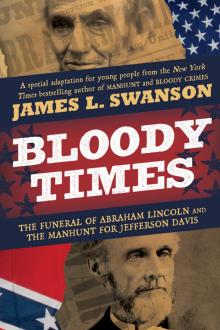 Bloody Times: The Funeral of Abraham Lincoln and the Manhunt for Jefferson Davis
Bloody Times: The Funeral of Abraham Lincoln and the Manhunt for Jefferson Davis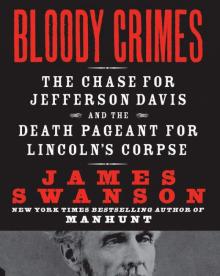 Bloody Crimes: The Funeral of Abraham Lincoln and the Chase for Jefferson Davis
Bloody Crimes: The Funeral of Abraham Lincoln and the Chase for Jefferson Davis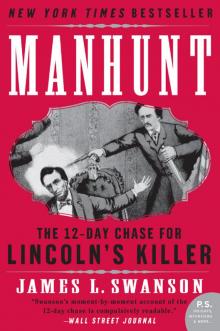 Manhunt: The 12-Day Chase for Lincoln's Killer
Manhunt: The 12-Day Chase for Lincoln's Killer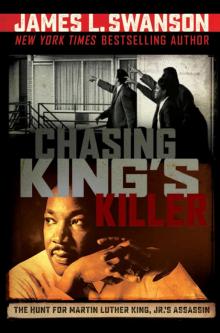 Chasing King's Killer: The Hunt for Martin Luther King, Jr.'s Assassin
Chasing King's Killer: The Hunt for Martin Luther King, Jr.'s Assassin Bloody Crimes
Bloody Crimes End of Days
End of Days Chasing Lincoln's Killer
Chasing Lincoln's Killer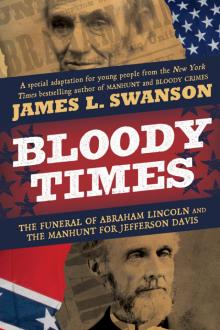 Bloody Times
Bloody Times Manhunt
Manhunt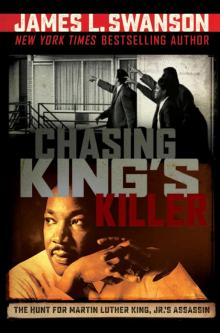 Chasing King's Killer
Chasing King's Killer